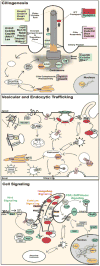Global genetic analysis in mice unveils central role for cilia in congenital heart disease
- PMID: 25807483
- PMCID: PMC4617540
- DOI: 10.1038/nature14269
Global genetic analysis in mice unveils central role for cilia in congenital heart disease
Abstract
Congenital heart disease (CHD) is the most prevalent birth defect, affecting nearly 1% of live births; the incidence of CHD is up to tenfold higher in human fetuses. A genetic contribution is strongly suggested by the association of CHD with chromosome abnormalities and high recurrence risk. Here we report findings from a recessive forward genetic screen in fetal mice, showing that cilia and cilia-transduced cell signalling have important roles in the pathogenesis of CHD. The cilium is an evolutionarily conserved organelle projecting from the cell surface with essential roles in diverse cellular processes. Using echocardiography, we ultrasound scanned 87,355 chemically mutagenized C57BL/6J fetal mice and recovered 218 CHD mouse models. Whole-exome sequencing identified 91 recessive CHD mutations in 61 genes. This included 34 cilia-related genes, 16 genes involved in cilia-transduced cell signalling, and 10 genes regulating vesicular trafficking, a pathway important for ciliogenesis and cell signalling. Surprisingly, many CHD genes encoded interacting proteins, suggesting that an interactome protein network may provide a larger genomic context for CHD pathogenesis. These findings provide novel insights into the potential Mendelian genetic contribution to CHD in the fetal population, a segment of the human population not well studied. We note that the pathways identified show overlap with CHD candidate genes recovered in CHD patients, suggesting that they may have relevance to the more complex genetics of CHD overall. These CHD mouse models and >8,000 incidental mutations have been sperm archived, creating a rich public resource for human disease modelling.
Figures



References
-
- Hoffman JI. Incidence of congenital heart disease: II. Prenatal incidence. Pediatric cardiology. 1995;16:155–165. - PubMed
Publication types
MeSH terms
Grants and funding
LinkOut - more resources
Full Text Sources
Other Literature Sources
Medical
Molecular Biology Databases
Research Materials

